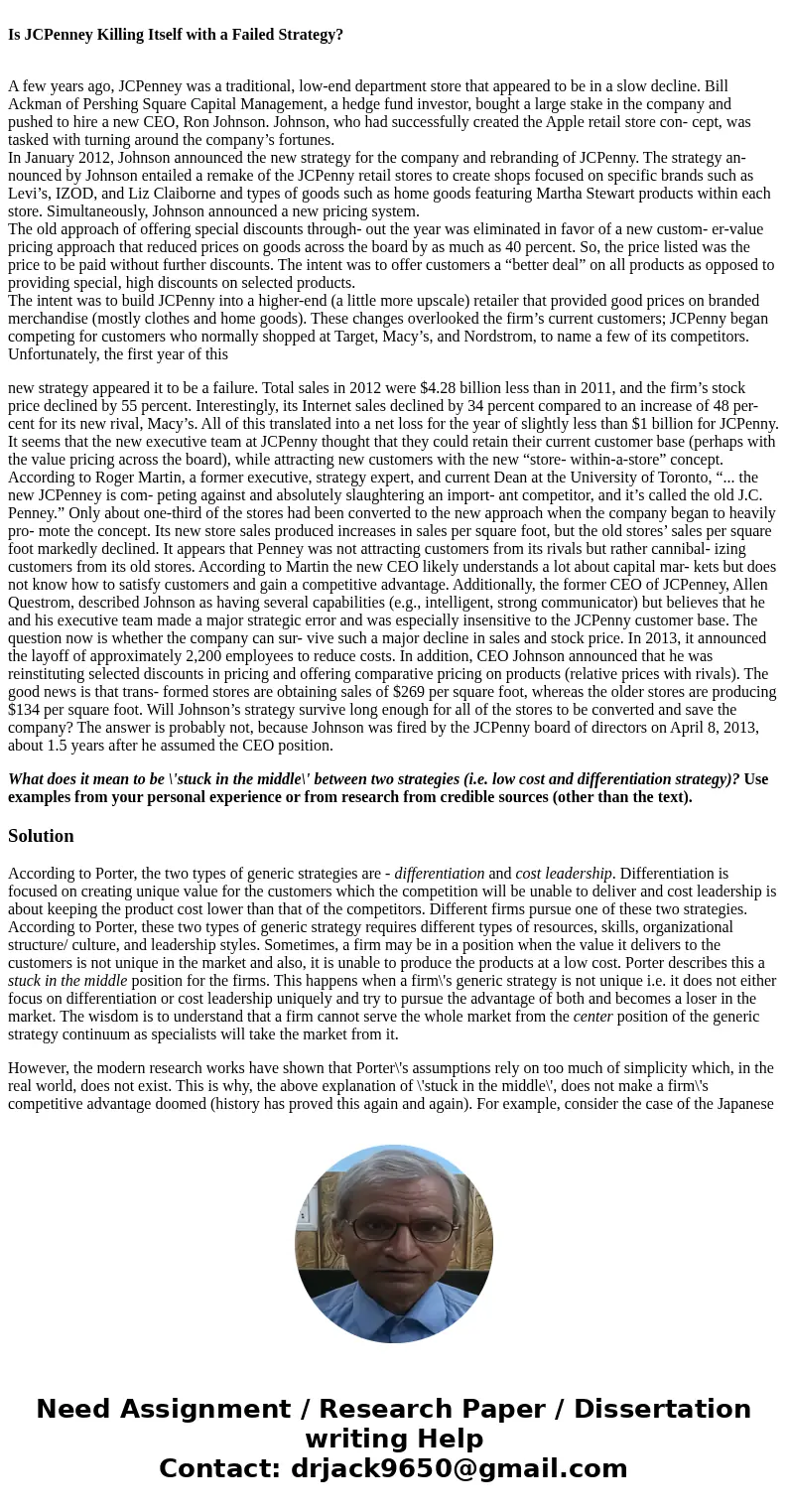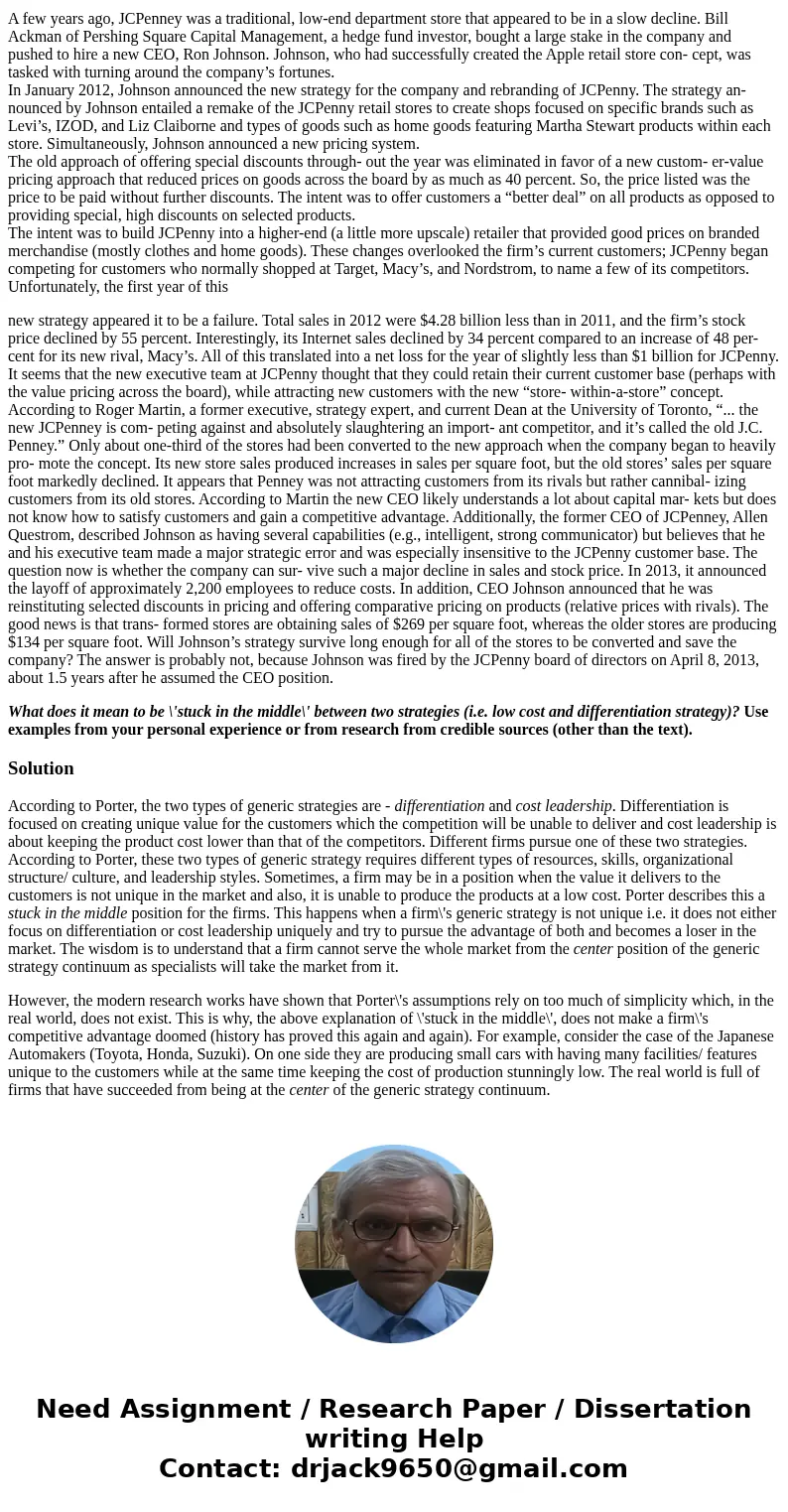Is JCPenney Killing Itself with a Failed Strategy A few year
Is JCPenney Killing Itself with a Failed Strategy?
A few years ago, JCPenney was a traditional, low-end department store that appeared to be in a slow decline. Bill Ackman of Pershing Square Capital Management, a hedge fund investor, bought a large stake in the company and pushed to hire a new CEO, Ron Johnson. Johnson, who had successfully created the Apple retail store con- cept, was tasked with turning around the company’s fortunes.
In January 2012, Johnson announced the new strategy for the company and rebranding of JCPenny. The strategy an- nounced by Johnson entailed a remake of the JCPenny retail stores to create shops focused on specific brands such as Levi’s, IZOD, and Liz Claiborne and types of goods such as home goods featuring Martha Stewart products within each store. Simultaneously, Johnson announced a new pricing system.
The old approach of offering special discounts through- out the year was eliminated in favor of a new custom- er-value pricing approach that reduced prices on goods across the board by as much as 40 percent. So, the price listed was the price to be paid without further discounts. The intent was to offer customers a “better deal” on all products as opposed to providing special, high discounts on selected products.
The intent was to build JCPenny into a higher-end (a little more upscale) retailer that provided good prices on branded merchandise (mostly clothes and home goods). These changes overlooked the firm’s current customers; JCPenny began competing for customers who normally shopped at Target, Macy’s, and Nordstrom, to name a few of its competitors. Unfortunately, the first year of this
new strategy appeared it to be a failure. Total sales in 2012 were $4.28 billion less than in 2011, and the firm’s stock price declined by 55 percent. Interestingly, its Internet sales declined by 34 percent compared to an increase of 48 per- cent for its new rival, Macy’s. All of this translated into a net loss for the year of slightly less than $1 billion for JCPenny. It seems that the new executive team at JCPenny thought that they could retain their current customer base (perhaps with the value pricing across the board), while attracting new customers with the new “store- within-a-store” concept. According to Roger Martin, a former executive, strategy expert, and current Dean at the University of Toronto, “... the new JCPenney is com- peting against and absolutely slaughtering an import- ant competitor, and it’s called the old J.C. Penney.” Only about one-third of the stores had been converted to the new approach when the company began to heavily pro- mote the concept. Its new store sales produced increases in sales per square foot, but the old stores’ sales per square foot markedly declined. It appears that Penney was not attracting customers from its rivals but rather cannibal- izing customers from its old stores. According to Martin the new CEO likely understands a lot about capital mar- kets but does not know how to satisfy customers and gain a competitive advantage. Additionally, the former CEO of JCPenney, Allen Questrom, described Johnson as having several capabilities (e.g., intelligent, strong communicator) but believes that he and his executive team made a major strategic error and was especially insensitive to the JCPenny customer base. The question now is whether the company can sur- vive such a major decline in sales and stock price. In 2013, it announced the layoff of approximately 2,200 employees to reduce costs. In addition, CEO Johnson announced that he was reinstituting selected discounts in pricing and offering comparative pricing on products (relative prices with rivals). The good news is that trans- formed stores are obtaining sales of $269 per square foot, whereas the older stores are producing $134 per square foot. Will Johnson’s strategy survive long enough for all of the stores to be converted and save the company? The answer is probably not, because Johnson was fired by the JCPenny board of directors on April 8, 2013, about 1.5 years after he assumed the CEO position.
What does it mean to be \'stuck in the middle\' between two strategies (i.e. low cost and differentiation strategy)? Use examples from your personal experience or from research from credible sources (other than the text).
Solution
According to Porter, the two types of generic strategies are - differentiation and cost leadership. Differentiation is focused on creating unique value for the customers which the competition will be unable to deliver and cost leadership is about keeping the product cost lower than that of the competitors. Different firms pursue one of these two strategies. According to Porter, these two types of generic strategy requires different types of resources, skills, organizational structure/ culture, and leadership styles. Sometimes, a firm may be in a position when the value it delivers to the customers is not unique in the market and also, it is unable to produce the products at a low cost. Porter describes this a stuck in the middle position for the firms. This happens when a firm\'s generic strategy is not unique i.e. it does not either focus on differentiation or cost leadership uniquely and try to pursue the advantage of both and becomes a loser in the market. The wisdom is to understand that a firm cannot serve the whole market from the center position of the generic strategy continuum as specialists will take the market from it.
However, the modern research works have shown that Porter\'s assumptions rely on too much of simplicity which, in the real world, does not exist. This is why, the above explanation of \'stuck in the middle\', does not make a firm\'s competitive advantage doomed (history has proved this again and again). For example, consider the case of the Japanese Automakers (Toyota, Honda, Suzuki). On one side they are producing small cars with having many facilities/ features unique to the customers while at the same time keeping the cost of production stunningly low. The real world is full of firms that have succeeded from being at the center of the generic strategy continuum.


 Homework Sourse
Homework Sourse